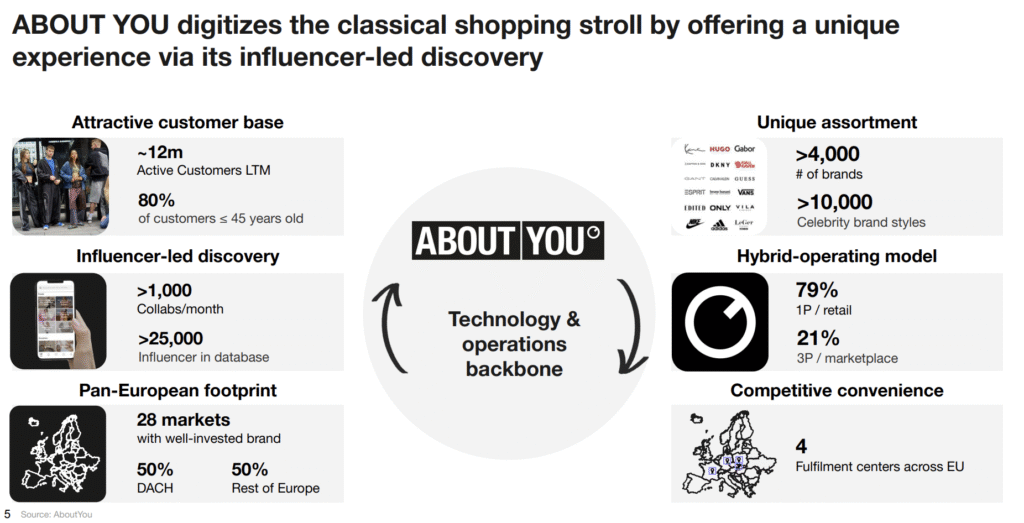Zalando is Europe’s largest online fashion retailer, and its recent acquisition of About You could turn it into the continent’s leading marketplace for designer and premium brands.
The deal was approved in the summer of 2025 without any objections from competition authorities. Because the transaction raised no antitrust concerns, the approval itself had little immediate impact on the stock price.
Beyond the acquisition, we identified several regulatory tailwinds that supported our decision to include the company in our portfolio:
- the introduction of new EU tariffs and duties on non-EU parcels,
- the elimination of existing exemptions for low-value imports, and
- ongoing investigations into Temu and Shein under the Digital Services Act.
Together, these measures could help level the playing field for European e-commerce platforms like Zalando, which have faced rising competition from Asian retailers. However, unlike larger M&A events or formal market investigations, these regulatory developments are slow-burn catalysts. Their full effect on Zalando’s performance will take time to materialize, as they depend on new legislation and enforcement cycles rather than single headline decisions.
Regulatory Events
In July 2025, Zalando completed its takeover of About You, securing EU clearance and moving swiftly to squeeze out remaining minorities by September. The deal folds a major German rival into Zalando’s platform, expanding brand/seller supply, data reach, and fulfilment density. Management framed 2025 guidance on a combined basis, underscoring that synergies are expected primarily from logistics, tech/marketing, and overheads—i.e., exactly where marketplace scale compounds.
Why it matters. In a market pressured by ultra-low-cost Chinese platforms, consolidating a domestic peer gives Zalando more leverage with brands, better ad monetisation, and denser last-mile routes—defensive and offensive at once.

EU squeezes Temu & Shein’s loopholes
On July 9, the European Parliament approved a set of measures aimed at curbing the influx of “substandard and potentially dangerous cheap goods from non-EU webshops.” Two of these measures are likely to directly impact Temu and Shein. First, the EU will end customs duty exemptions on parcels under €150. Second, the Parliament endorsed the Commission’s proposal to introduce a €2 handling fee on individual e-commerce packages arriving from outside the EU.
These new rules specifically target ultra-low-cost retailers from China, eroding the price advantage they currently enjoy through cheap cross-border shipping. By raising compliance and import costs, the EU aims to create a fairer environment for European retailers. Shipments from China to Europe are expected to rise after the U.S. ended its small-parcel import exemptions. Early data already point to a sharp drop in Shein and Temu’s U.S. sales, and analysts predict a redirection of products toward Europe, where higher U.S. costs make the market relatively more attractive.
These regulatory moves could indirectly support Zalando by raising compliance costs for its foreign rivals.
European Commission investigates Shein, Temu, and AliExpress
Zalando’s fiercest competition comes from Asia. Ultra low-cost online retailers Shein, Temu, and AliExpress are exerting significant pressure—so much so that in April, Morgan Stanley downgraded Zalando’s rating to “underweight,” citing this intensifying competition.
The European Commission is responding by ramping up scrutiny of these platforms to level the playing field for European retailers. Under the Digital Services Act (DSA), AliExpress is facing formal proceedings for failing to control illegal and counterfeit listings. Although it has made commitments in one investigation, a second probe remains open. Meanwhile, Temu and Shein are being investigated for manipulative interface designs and inadequate consumer protections.
In our view, these are regulatory tailwinds that could help the company in the mid-term.
Company Analysis
What it does. Zalando is Europe’s largest online fashion marketplace, spanning B2C retail and a fast-growing B2B “ecosystem” (brand storefronts, logistics/fulfilment via ZEOS, advertising/marketing tools). The pitch to brands is simple: one integration to reach 20-plus European markets with logistics, payments, returns, and customer acquisition bundled in.
Latest quarter: steady growth, profitability intact
Q2 2025 showed GMV +5% to ~€4.1bn, revenue +7.3% to ~€2.84bn, and adjusted EBIT €185–186m with a 6.5% margin—solid progress on growth while holding profitability. Active customers reached ~52.9m (+6.1% YoY). For FY-2025, Zalando guides the combined group to GMV €17.2–17.6bn, revenue €12.1–12.4bn, and adjusted EBIT €550–600m.
Analyst take. The print reinforces three themes: (1) ecosystem flywheel—About You adds supply and audience; (2) mix/monetisation—ads and B2B services carry higher incremental margins than plain retail; (3) policy tailwinds—customs and product-safety enforcement raise rivals’ costs at the low end. Execution watch-items: integration of About You (tech stack, logistics overlap), maintaining 6–7% adj. EBIT margin while investing in growth, and competitive response from Shein/Temu if EU timelines slip.
Growth is modest, not explosive—but consistent. The low-to-mid single-digit revenue / GMV growth shows saturation in core markets but some runway via cross-border expansion, deeper monetization, and the About You integration. The fact that revenue is growing faster than GMV suggests better monetization (higher take rates, more services, stronger mix) rather than purely volume growth.
Analyst Views & Market Sentiment
- Several analysts point out that the market undervalues Zalando’s margin trajectory and monetization potential, especially as the About You integration boosts scale, densifies logistics, and enhances ad / services revenue. (e.g., one analysis notes EBIT margin improving from 1.1% in 2023 to ~2.5% in 2025)
- Some skeptics warn that growth in core Western European markets is mature, and further expansion will require higher marketing spend or discounting, which compresses margin.
- The B2B / platform side is viewed by many as the wild card: if Zalando can successfully grow and monetize it, returns could surprise upward—but if not, it may remain a drag.
- The regulatory angle is increasingly factored in: many investors see EU moves on customs / de-minimis as latent tailwinds rather than guaranteed catalysts.
- Timing and execution risk on integrating About You is a recurring caution. If systems, logistics, or culture misalign, realized synergies could lag.